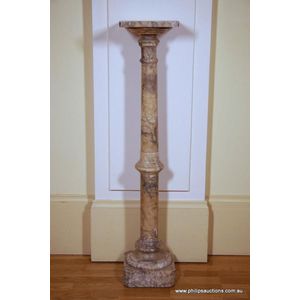Mottled Alabaster Pedestal
You must be a subscriber, and be logged in to view price and dealer details.
Subscribe Now to view actual auction price for this item
When you subscribe, you have the option of setting the currency in which to display prices to $Au, $US, $NZ or Stg.
- Socle - The short plinth, usually cylindrical, that serves as a pedestal for a sculpture or vase
- Canted Corners - In decorative arts, especially furniture making, a canted corner refers to a technique where the corner of the piece is angled or "canted" to create a diagonal corner. This is different from a chamfered corner which is a technique where the edges of a corner are cut at an angle, creating a diagonal edge or "bevel" along the corner.
A canted corner is typically used to add visual interest to the item. It can be found in various styles of furniture such as contemporary, Art Deco, or traditional. It is often used to create a sense of movement and dynamism in a piece.
Canting a corner is a more complex technique than chamfering, and it is typically done by tilting the corner of a piece of furniture and then cutting the wood to match the angle. It's a technique that requires precise measurements and a good understanding of angles and geometry, and it is usually done by experienced artisans. - Alabaster - Alabaster is soft natural stone used for statuary, with a similar appearance to marble, but easier to work with. As it is softer than marble, an item made from alabaster can be scratched with a metal object, and an alabaster item does not polish to a high surface gloss like marble.
Alabaster objects can be semi-translucent. Alabaster occurs in a pure white form and also with veining from dirt. Colours vary from white through yellow and pink to brown. The veining is usually green or black but can be multicoloured.
Being semi-translucent, alabaster is often used for the bowls of figural lamps, with the figure itself being either alabaster or marble.
This item has been included into following indexes:
Visually similar items

A marble pedestal, in mottled amber tones with black veins, and of simple lines with a square top, a cylindrical column with a single band to the top and bottom, and raised on a stepped rectangular base. Height 112 cm

A Victorian alabaster pedestal, 19th century, with a semi circular top upon a spiral stem with a central lobed 'Garlic bulb' knop to a spreading stepped base and a faceted plinth. Height 125 cm. Width 62 cm. Depth 28 cm

Antique Victorian brass barley twist candlestick converted to a lamp

A pair of Louis XV style gilt bronze mounted rouge marble pedestals, late 19th century, 109.5 cm high, 32 cm wide, 32 cm deep
